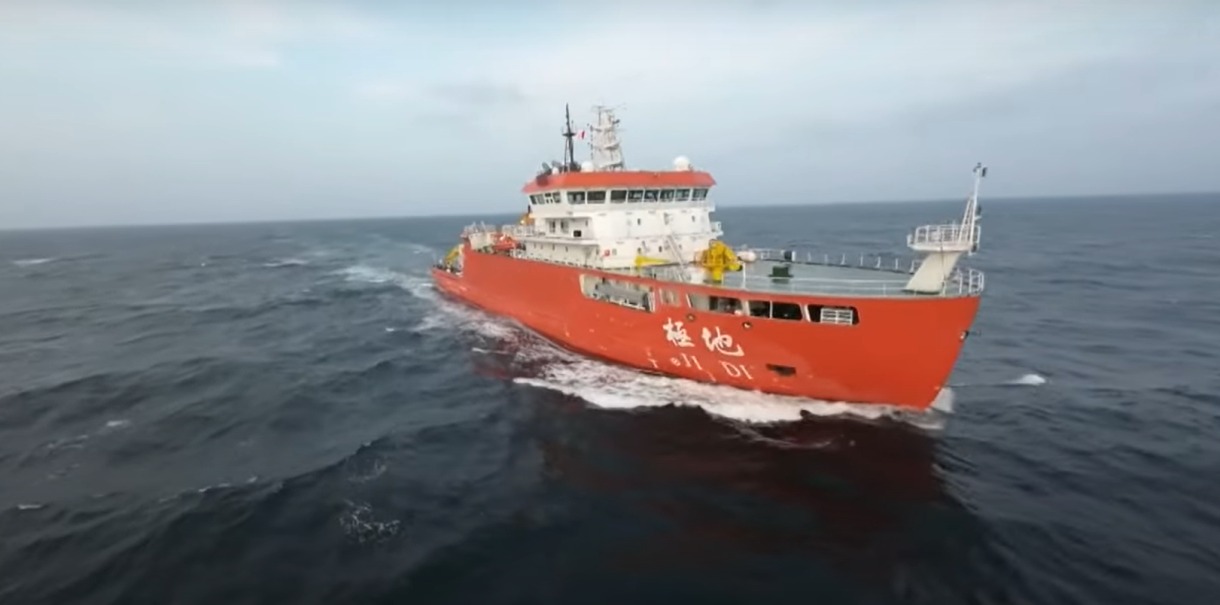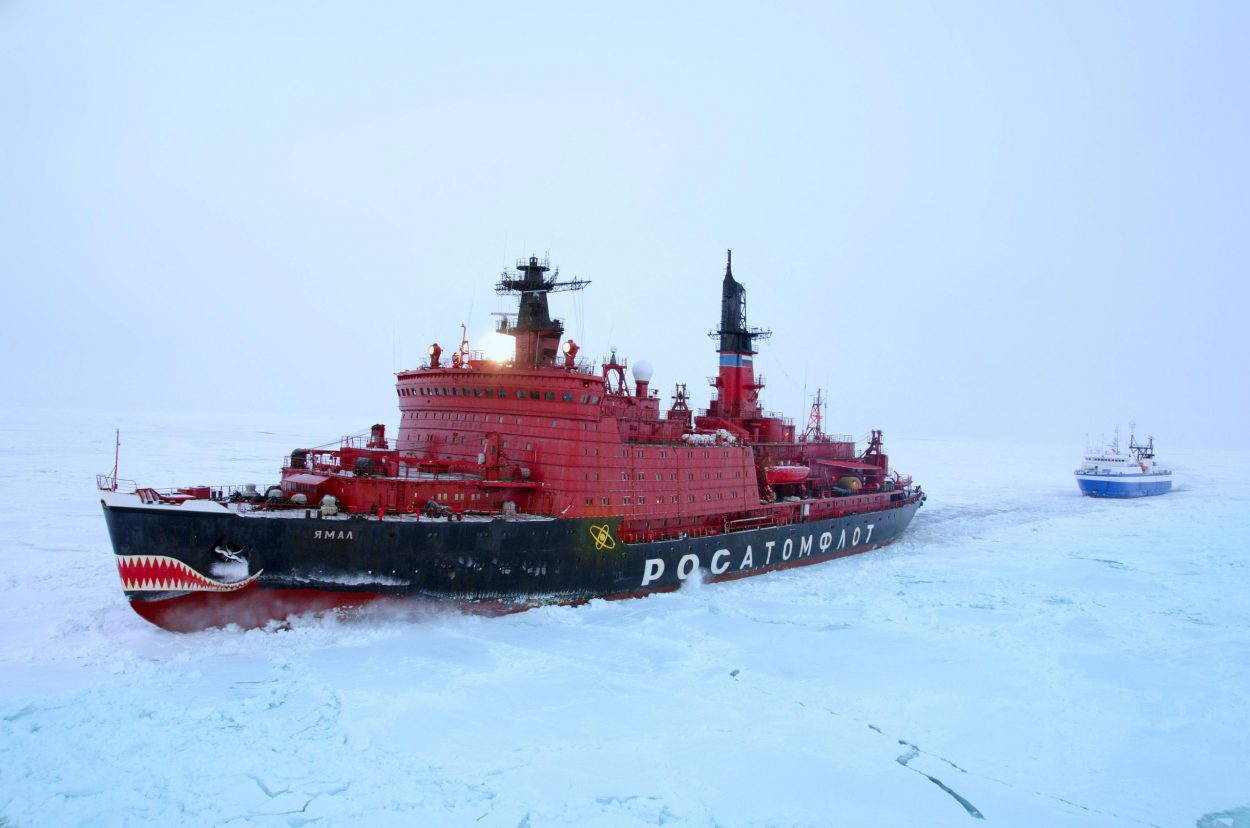In a chilly twist of international competition, China has just unveiled its latest weapon in the battle for polar supremacy—the icebreaker ship “Ji Di.” This frosty behemoth, China’s fourth polar research vessel, recently made its grand debut in Guangzhou, leaving India scrambling to catch up in the competitive realms of Arctic and Antarctic exploration.
China recently celebrated the delivery of its new-generation Polar Research Vessel (PRV), commonly known as the icebreaker ship Ji Di. The vessel was officially named and delivered to the Ministry of Natural Resources in Guangzhou’s Nansha district. This addition aims to enhance China’s capabilities in marine disaster prevention and mitigation.
The Dragon’s Icy Breath
Ji Di, China’s fourth polar research icebreaker, is the latest in its next-generation fleet. It facilitates year-round scientific expeditions to critical polar regions. Another Polar Class 4 icebreaker, tentatively named ‘Tan Suo San Hao,’ was launched in April 2024 and is expected to join the fleet soon.
Currently, China employs its first two icebreakers, MV Xue Long and MV Xue Long 2, for supply missions to its seven Arctic and Antarctic stations. The MV Xue Long, an ice-strengthened cargo ship, was purchased from Ukraine in 1993 and subsequently modified and refurbished to meet China’s operational requirements in polar regions. The MV Xue Long 2, or ‘Snow Dragon 2,’ is a domestically-built Polar Class-3 vessel.
Ji Di is expected to begin research duties in the second half of 2024, according to China Central Television (CCTV). Affiliated with the North Sea Bureau of China’s Ministry of Natural Resources, Ji Di is a new-generation ice-breaking research vessel independently designed and developed by Guangzhou Shipyard International Company Limited, a subsidiary of the China State Shipbuilding Corporation Limited (CSSC).
Measuring 89.95 meters in length, 17.8 meters in beam, and with a design speed of 15 nautical miles per hour, Ji Di is capable of worldwide navigation.
Chief designer Cai Ruimou stated while talking to the media that Ji Di can conduct polar and deep-sea surveys during the summer and navigate the Yellow Sea and Bohai Sea in the winter to break the ice, monitor the marine environment, measure seawater, and perform rescue missions in icy areas.
After delivery, CCTV reported that Ji Di will focus on comprehensive investigations, observations, and research tasks involving polar ocean conditions, sea ice, and atmosphere, enhancing China’s marine disaster prevention and mitigation capabilities with its advanced marine observation and sampling equipment.
Construction of Ji Di was awarded to Guangzhou Shipyard International in March 2022 and began shortly thereafter. The vessel was floated out on December 29, 2023, and delivered on June 24, 2024. Built to Polar Class 6, Ji Di is intended for summer and autumn operations in medium first-year ice, which may include small inclusions of old sea ice.
Global Icebreaker Fleets
Countries with the largest fleets of icebreakers are typically those with significant ice-covered territories. These include Russia, the USA, Canada (Coast Guard and Royal Canadian Navy), China, Finland, Sweden, and Germany. Notably, Russia, the USA, and Canada operate four of the five largest icebreakers in the world. Notably, Russia operates the world’s largest and most powerful nuclear icebreakers.
Other countries with icebreakers in their fleets include Argentina, Australia, Austria, Azerbaijan, Chile, Denmark, Estonia, France, Italy, Japan, Kazakhstan, Netherlands, Norway, Poland, Ukraine, and the UK.

In this roster of nations with robust icebreaker capabilities, India’s absence is conspicuous.
Why Doesn’t India Have Polar Research Vessels?
For the past few years, India has been striving to either acquire or construct a Polar Research Vessel (PRV), but this goal has yet to be achieved.
Despite operating two polar scientific research stations in Antarctica—Bharati and Maitri—and one in the Arctic—Himadri in Ny-Ålesund, Svalbard, Norway—India continues to rely on chartered foreign PRVs for its polar expeditions.
To date, India has successfully conducted 42 annual scientific expeditions, including polar expeditions, which have been conducted by chartering foreign PRVs. The recent use of the Russian icebreaker Dmitry Golovnin for an expedition underscores this dependency.
India actively constructs various types of vessels. However, the primary hurdle for India lies in the limited capabilities of its shipbuilding industry to construct PRVs. Globally, few companies specialize in building these specialized vessels, leaving India with the option of direct purchase or joint ventures to meet its needs.
Russia & India’s Icebreaker Alliance
Recognizing the need for more icebreakers, India and Russia have explored collaborative opportunities, including the potential construction of non-nuclear icebreakers in Indian shipyards.
“We may see Russian icebreakers being built at Indian shipyards,” said Union Minister for Ports, Shipping and Waterways Sarbananda Sonowal in January 2024.
Russia faces a significant need for more icebreakers and is looking to shipbuilders in China and India for additional construction capacity due to delays at domestic yards. Russian President Vladimir Putin has prioritized increasing traffic on Russia’s Northern Sea Route (NSR), aiming to boost cargo traffic from 35 million tonnes a year to 200 million tonnes by 2031.
India has proposed to Russia that the two countries collaboratively manufacture non-nuclear icebreakers in Indian shipyards. In Sept 2023, Alexey Chekunkov, the Russian Federation’s Ministry of Eastern Development director, announced in an interview with Sputnik and RIA Novosti on the sidelines of the 8th Eastern Economic Forum (EEF).
Chekunkov recalled that the delegation from India negotiated with FESCO on the organization of container transportation. It was reported that FESCO plans to open a hub in India to organize freight transportation.
The minister also mentioned that, in conjunction with the Indian Ministry of Ports, Shipping, and Waterways, plans were underway to initiate a maritime line connecting the port of Chennai in India with the city of Vladivostok in Russia.
India has not previously engaged in the construction of icebreakers, but China has recently accomplished the delivery of a substantial icebreaker vessel and other trading vessels with ice-class capabilities.
Russia has acquired a significant amount of rupees due to its shift towards conducting trade in domestic currencies. It would be advantageous to utilize these rupees as a means of payment for goods produced in India.
How Could An Independent PRV Help India?
India’s acquisition of an independent PRV with icebreaking capabilities is crucial. Such a vessel would reduce dependency on foreign charters for logistical and scientific missions, enhance the skills of Indian sailors in polar waters, and bolster India’s scientific autonomy in polar research.
Moreover, it would enable year-round operations at India’s polar bases and support future deep-sea research missions involving advanced technologies like Unmanned Underwater Vehicles (UUVs) and submarine cable networks.
Strategically, a PRV would extend the Indian Navy’s operational reach in polar regions, underlining its multifaceted significance for India’s scientific, economic, and strategic interests.
What Is An Icebreaker Ship?
Icebreaker ships are specially designed to navigate through and break thick ice, making otherwise inaccessible polar regions traversable. Key features include a strengthened hull, an ice-clearing shape, and extreme power to push through sea ice.
Primary Functions
Icebreakers clear trade routes in icy waters, especially during winter. Even though vessels on routes like the Baltic Sea, Saint Lawrence Seaway, Great Lakes, and Northern Sea Route are designed for icy conditions, seasonal ice can be challenging.
Icebreakers escort commercial vessels through such areas to ensure safe navigation and support polar research programs.
Key Features
-
Strengthened Hull: Built thicker than other ships, using steel that withstands low temperatures.
-
Hull Shape: Designed with low ice resistance, featuring a double hull for extra durability.
-
Enhanced Maneuverability: Includes a sloping or rounded stem and sloping sides to improve navigation through ice.

Nuclear Icebreaker Ships
In 1957, the Soviet Union fulfilled the need for a vessel capable of clearing paths and breaking ice with the world’s first nuclear-powered surface ship, an icebreaker.
Nuclear icebreaker ships represent the latest advancements in ice-breaking technology, making them ideal for the harsh job that these ships are destined for. These ships are highly cost-intensive, mainly due to fuel costs.
Russia (Soviet Union) is the only country constructing nuclear-powered icebreakers. These ships are crucial for maintaining the Northern Sea Route and ensuring the safety of Russian trade vessels during winter, as well as supplying Arctic settlements. Russia operates the largest fleet of icebreakers, with approximately 40 ships, including eight nuclear-powered ones.
Russia owns the world’s largest and most powerful icebreaker, the NS 50 Let Pobedy, an Arktika-class vessel that is 524 feet long and can break through ice up to 2.8 meters thick. The newest in this class, the Arktika, is part of Project 22220 and is 570 feet long and 168 feet tall, providing excellent visibility and ice-breaking capabilities.
Limitations & Future Developments
Icebreaker ships dominate the polar regions and icy waters worldwide but are less efficient outside these specific areas. Their specialized design, optimized for ice breaking, renders them less suitable for normal waterways. With a rounded bow, icebreakers struggle in regular seas where typical hull shapes fare better against waves.
This design limitation complicates maneuvering, making modifications like the double-acting ship design necessary to address these challenges. Double-acting ships feature propellers that can rotate in all directions, enabling them to generate thrust while moving backward to break ice. Despite advancements, icebreaker ships remain the primary choice for icebreaking until double-acting ships become more widely adopted.
In conclusion, while China advances its capabilities with the delivery of Ji Di, India navigates strategic partnerships and domestic challenges to realize its ambitions in polar research and maritime operations.
The acquisition of a PRV remains crucial not only for scientific endeavors but also for enhancing India’s economic and strategic interests in the Arctic and Antarctic regions.
- Shubhangi Palve is a defense and aerospace journalist. Before joining the EurAsian Times, she worked for E.T. Prime. In this capacity, she focused on covering defense strategies and the defense sector from a financial perspective. She offers over 15 years of extensive experience in the media industry, spanning print, electronic, and online domains.
- Contact the author at shubhapalve (at) gmail (dot) com.




